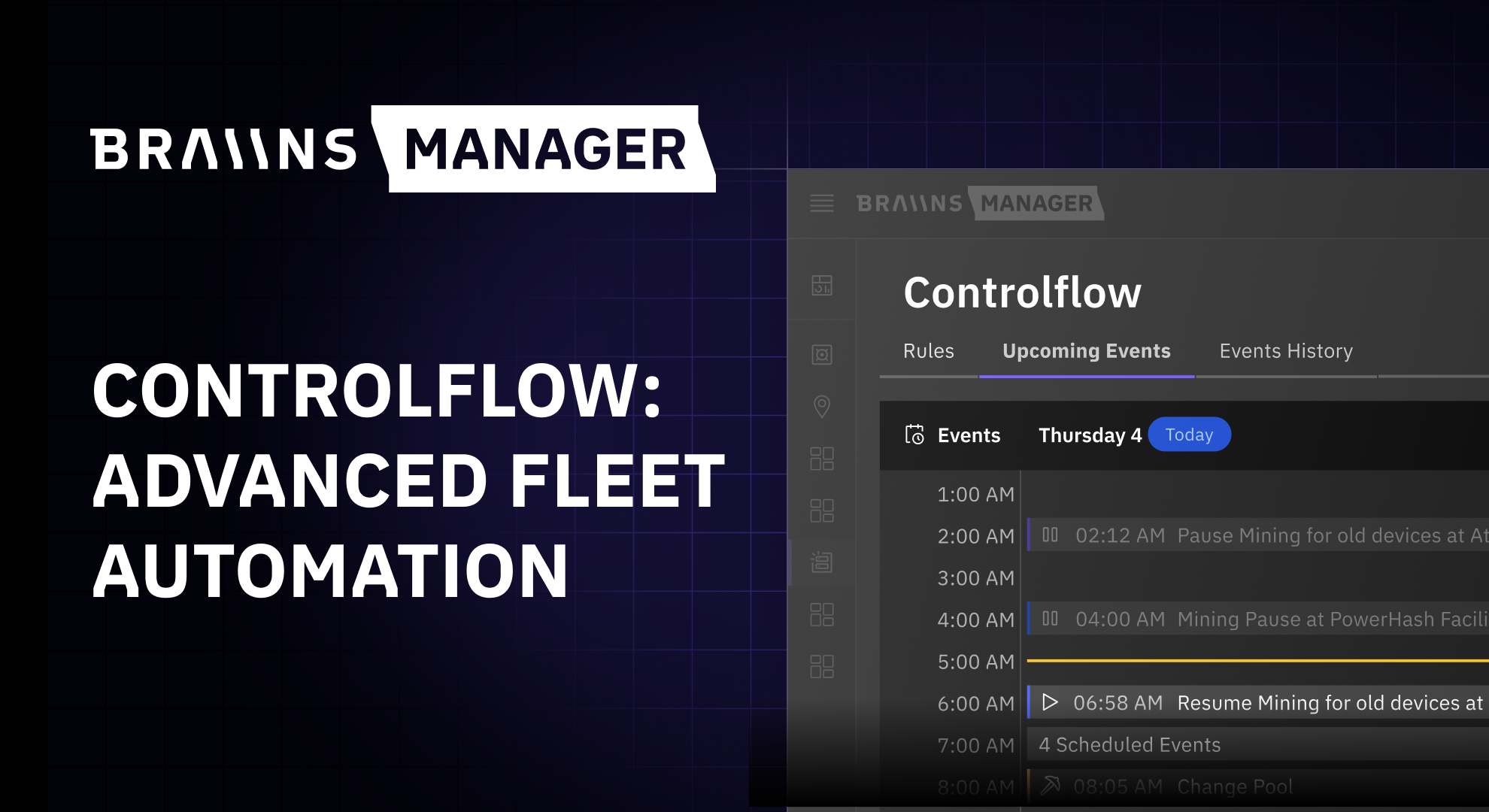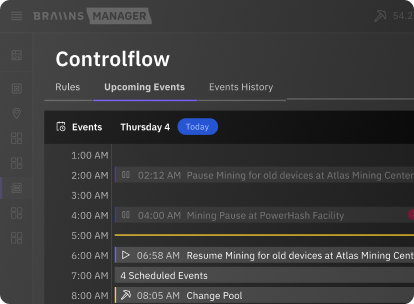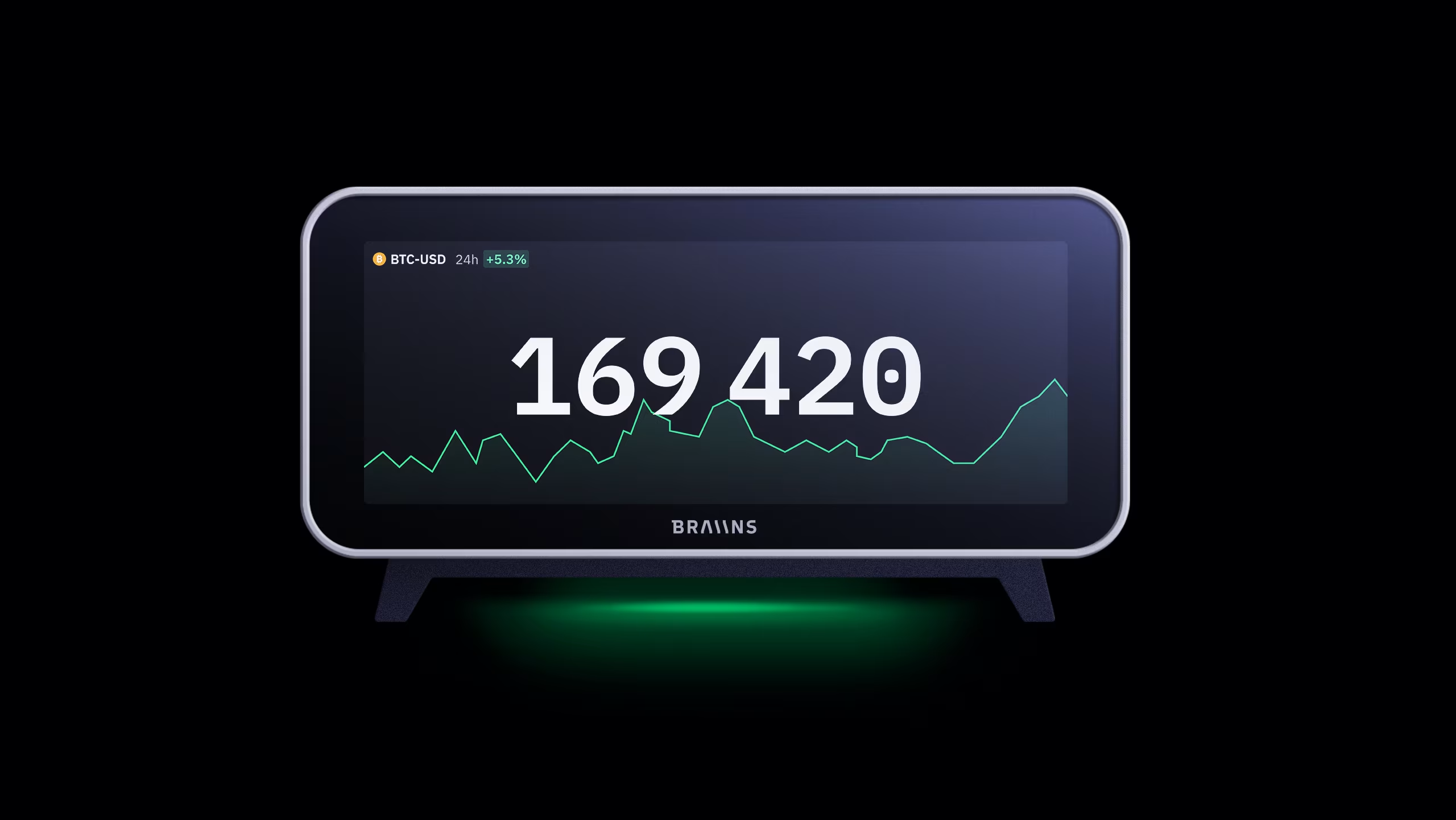Optimizations for Bitcoin Mining with Intermittent Energy Sources
Published
21.7.2021
Exploring methods to reduce capital expenditures (CapEx) and operational expenditures (OpEx) as well as improve ASIC hardware lifespan for bitcoin miners with intermittent power supplies.

Table of Contents
Since Bitcoin entered the ASIC mining era in 2013, the lion’s share of advancements have happened with hardware. The first ASIC—the Avalon1 released by Canaan in 2013— had a hashrate of 60 GH/s and a consumption of 595 W. With today’s efficiency terms, that’s just under 10,000 W/TH.
In the next four years, efficiency improved by two orders of magnitude as the release of the Antminer S9 in 2016 took us below 100 W/TH. However, efficiency gains are now beginning to slow down significantly. The best ASICs of 2021 hash at around 30 W/TH, and are only ~10-20 W/TH more efficient than their mid-gen predecessors.
As the playing field gradually levels out for hardware, one of the ways miners are finding competitive advantages now is via more sophisticated Power Purchasing Agreements (PPAs) and by setting up next to intermittent power sources to consume surplus energy. For example, several miners in Texas are now acting as Controllable Load Resources in the ERCOT (Electric Reliability Council of Texas) system, meaning that they agree to consume less power when there is high demand from the grid and in exchange they pay much lower prices (e.g. 1 - 3 ¢/kWh) for their electricity the rest of the time.
With these inconsistent and intermittent energy supplies, miners must develop customized strategies to determine how much energy they consume at any given time. In this article, we’ll discuss some of the optimizations these miners can make in planning and running their operations to maximize profitability.
The Rise of Intermittent Energy
The chart below shows the growing capacity of Variable Renewable Energy (VRE) in the UK and Germany from 2007 to 2016, and with it the growing amount of curtailment (i.e. reduction in power output below what could have been produced) occurring in order to balance energy supply and demand. Similar trends are taking place all over the developed world.

As discussed in the Economics of Bitcoin Mining with Solar Energy, plugging bitcoin miners in to consume surplus power (e.g. RES curtailment in the chart above) is not always a straightforward win. Miners need to have high uptime, otherwise there is a significant risk that the ASICs will never reach a positive ROI even with extremely cheap or free electricity.
From the moment they purchase hardware, miners are on a time crunch to maximize their BTC mined no matter how cheap their electricity may be. This is because, with the exception of today’s unprecedented mining profitability resulting from China’s nationwide crackdown, the Bitcoin network difficulty has been steadily climbing to the tune of ~8% monthly increases during the modern ASIC era. In other words, the BTC mined per hash has been decreasing by ~8%/month during that time.
As difficulty climbs and hashvalue (BTC/TH/day) decreases correspondingly, the returns generated from the initial CapEx investment into ASIC hardware slow down. For example, the chart below compares the returns over 24 months for an ASIC with 100% uptime vs. 70% uptime. While the revenue from the ASIC with 100% uptime exceeds the cost of the ASIC (in BTC terms) during Month 12, the same never occurs for the ASIC with 70% uptime. This simply illustrates that it doesn’t matter how low your operating costs are if you sacrifice too much revenue.

If the total mining revenue produced by an ASIC never exceeds the initial amount paid for it and the costs to run it (in BTC terms), then it would be better to simply buy BTC in the beginning and not mine.
So, what can be done to improve the economics of this new generation of mining operations using intermittent energy sources and/or participating in load balancing programs?
More Expensive Energy is Better than No Energy
The simplest way to make a mining operation viable with a highly intermittent energy source is by using another energy source the rest of the time, such as natural gas, grid power, or some of the power stored in batteries from the intermittent source (e.g. solar or wind).
In that scenario, it’s unlikely that the secondary energy source will be cheap relative to the primary one. Natural gas will likely have higher CapEx to set up the necessary infrastructure, while grid energy and battery power will have other sources of demand to drive the spot price higher.
For the sake of this analysis, suppose that a miner gets an average of 8 hours per day of “free” electricity from solar panels during peak production, but they then have to pay the same price as regular consumers, say 8 ¢/kWh, for their energy during the remaining 16 hours per day.
At the time of writing, network difficulty is at 1-year lows and it would still be extremely profitable to mine at 8 ¢/kWh using practically any modern ASIC from the Antminer S9 up. But planning a mining operation based on the profitability of the post-China-crackdown time period would not be wise. Instead, let’s see how a mixed-energy strategy would hold up in much more competitive times, after all of the Chinese hashrate has come back online elsewhere in the world.
In other words, let’s keep BTC price at $35k but set difficulty to 40T (realistic for late 2022) to better illustrate the difference between surplus energy and grid energy during more normal times.
We’ll start by looking at an Antminer S17 with free electricity for 8 hours per day and 8 ¢/kWh the remaining 16 hours.


This means that you would make $2.21 (⅓ * $6.65) profit each day during the 8 hours with free electricity, and $1.15 (⅔ * $1.78) of profit the other 16 hours for a total of $3.36. Put another way, you increase your daily profit more than 50% by running the miners on the more expensive electricity rather than just shutting them off for those 16 hours.

But let’s not stop there. In a future scenario where mining is ultra-competitive once again, the efficiency gains and added flexibility of an autotuning firmware can make a huge difference. Enter Braiins OS.

During the 8 hours per day of free electricity, running Braiins OS and improving efficiency by 5 W/TH while at the stock power consumption limit (2520 W) boosts profitability from $6.65 to $7.49 per 24 hours. But the real magic is in the remaining 16 hours, when ASIC efficiency matters more due to the much higher electricity costs. With autotuning, the stock hashrate of 56 TH/s can be achieved with a power consumption of about 2150 W instead of 2520 W, bringing down total consumption while boosting margins.

Adding up our two time periods again, we get $2.50 of profit each day for the free 8 hours and $1.63 of profit the other 16 hours, for a total of $4.13 per day — a 23% profitability increase compared to stock firmware and an 87% profitability increase compared to stock firmware without a secondary energy source… not to mention an extra 800 satoshis mined per machine each day.

Furthermore, if the miner in this scenario can’t easily access the same amount of electricity from their secondary energy source (e.g. natgas, grid, or batteries) as they do from their primary energy source, they could go the route of minimizing consumption (and costs) by running the ASICs at a much lower power setting. This has the benefit of maximizing efficiency, so the miner will get the most possible sats per Watt.

The downside here is mining less BTC relative to mining with a higher power input, but if the biggest goal is minimizing expenses and maximizing profit margins then this would be the way to go.
In summary:
- Mining with intermittent energy sources makes a lot more sense if they can be supplemented by another energy source to maintain uptime
- Autotuning firmware can increase flexibility, allowing for a significant reduction in the energy consumption when electricity costs are higher and improving efficiency across the board
This second point is worth diving deeper on, as it can also apply to miners participating in load balancing programs for another reason besides immediately reducing operating expenses.
Optimizing Profitability and ASIC Lifespan for Load Balancing Miners
So, we’ve optimized to increase uptime and significantly boost daily profitability — are we done? Not quite.
You see, it’s not just the time spent on and off that matters for long-term ASIC profitability, but also the number of times transitioning between the two states. The hashing chips in an ASIC are made of silicon, and this material operates at quite high temperatures during mining (70-85oC or 158-185oF). Then, when the ASIC is powered off for a while, the chips return to ambient temperatures. The process of heating up and cooling down the material is called thermal cycling, and it can result in an accelerated degradation of the silicon chip quality.
There is no public data (yet) to help quantify the effect of frequent thermal cycling on any popular ASIC models, so we’re not going to estimate the months it may take off of an ASIC’s life or the loss in efficiency it may cause during the lifespan. However, it’s safe to assume that less frequent thermal cycling is better than more frequent thermal cycling for hardware lifespan, all else held equal.
Given this assumption, miners participating in load balancing programs and those using intermittent energy sources can help preserve their hardware by keeping it running in all but the most extreme peak demand scenarios. For example, let’s imagine a mining operation with 20 MW of power that turns off approximately 10 MW for 4 hours each day on average to accommodate peak demand from the grid.
First, we’ll run the numbers for an operation that uses stock firmware and simply powers off half of its miners to reduce consumption by 50%.

With the price ($35k) and difficulty (14.36T) at the time of writing as well as a 6% monthly difficulty increase, this is a fairly profitable operation. The electricity price is set to just 3 ¢/kWh because miners typically secure lower prices from energy providers by agreeing to reduce their consumption during peak demand periods.
However, a little extra sophistication can go a long way for miners who have made these types of PPAs (Power Purchase Agreements). For example, rather than turning off half of the ASICs and leaving the other half running, the optimal solution would be to reduce the power consumption of all the machines by 50%. Custom firmwares like Braiins OS allow for this kind of flexibility, while additionally increasing the TH/W of the miners at any power limit through autotuning. So let’s compare the same operation as above, but this time with Braiins OS and reducing consumption by 50% for all machines rather than turning half of them off. (Average hashrate calculated here.)

We see a 14% reduction in the operation’s average cost to mine 1 BTC and an additional 256 BTC mined over the 2-year period. The real game changing optimization occurs in those four hours when the miners have to reduce their power consumption 50%. By turning off half of the machines, the miners don’t improve their efficiency at all. But by running all of the machines at 50% of the power consumption, the efficiency improves significantly and the total hashrate drops by only ~42% rather than 50%.
Even if there were no implications at all on hardware lifespan, this would still be an optimal strategy to maximize daily returns in a load balancing application. The reduced frequency of thermal cycling is just a massive cherry on top that can make this sustainable for months or even years longer than it would have been with a less sophisticated strategy. It’s a win-win.
And it’s the same idea for the miners with intermittent energy sources like solar. Sure, grid or battery energy may be much more expensive than the surplus solar during peak generation, but changing strategies and maximizing ASIC efficiency during those more expensive periods can do wonders for both monthly cash flow and reducing the CapEx payback period by improving uptime.
Decreasing CapEx with Overclocking
Finally, one more optimization to consider along the same lines as the ones above is purchase an amount of ASICs which would consume all of your available power when overclocking, rather than doing so with stock settings. Phrased differently, consume more power per ASIC so that you don’t have to buy as many machines to fill your capacity, bringing down your initial CapEx investment.
And since we’re looking at minimizing CapEx, let’s run the numbers with some old-gen Antminer S9s going into a 5 MW operation. As usual, we’ll start with the standard machine specs, then compare with the non-standard adjustment.
Prices unfortunately haven’t come down as far for S9s as newer models, likely because there were not very many S9s left in China to begin with. Today we’re seeing S9s selling for about $25/TH, which works out to $338 for a 13.5 TH/s S9 that consumes 1160 W. To fill the 5 MW facility to 90% capacity, we need 3,880 machines costing a total of $1.31MM. We’ll ignore other infrastructure costs and make this our total CapEx just to keep things simple. Finally, we will assume this miner is using surplus solar with no secondary energy source, so uptime is conservatively set at 40%. Here are the results.

That’s already very good! Initial CapEx (and current difficulty) are low enough that it’s possible to break even on the hardware purchase in under a year with just 40% uptime. Cheaper old-gen machines are likely the way to go in a scenario with free or extremely cheap electricity but low uptime.
Now let’s see how much better we can do with Braiins OS specs. The default power limit for an Antminer S9 with Braiins OS is 1420 W and it can produce 16-17 TH/s at that input, with approximately the same efficiency as an S9 running stock firmware with 1160W consumption.
With per-machine consumption much higher, we only have to buy 3,169 rigs to fill the 5 MW capacity to 90%, for a CapEx of $1.07MM. Keeping all other variables the same as above, let’s see what we get.

Our monthly revenue and profit are essentially the same as the original case, but our CapEx break even occurs 3 months faster thanks to doing the same work with fewer machines by using Braiins OS at a higher power limit.
It’s worth noting that a change in cooling costs isn’t factored in here. Since heat output is directly correlated to power input, the total heat produced in the two scenarios should be the same. However, the density is higher in the second case, so cooling costs could be slightly higher as well.
While on the topic of cooling, there are also a lot of interesting things to talk about with immersion cooling for the scenarios analyzed throughout this article. Immersion makes it safer and more efficient to overclock ASICs well beyond what can be done with air cooling, and it significantly reduces monthly OpEx for cooling. However, it’s very capital intensive up-front, so economic analysis should be done to determine if that CapEx will pay off with the increased overclocking capacity and potentially improved hardware lifespan and long-term efficiency. A topic for another article or two...
Looking Ahead
As we look 6+ months into the future, it’s apparent that bitcoin mining is going to become ultra-competitive once again. Many Chinese miners have entered into joint ventures to build out new infrastructure around the world where they can redeploy the ASICs that went offline following the ban. Mining companies across North and South America are also scaling fast, with some of the publicly traded companies adding tens of thousands of new-generation ASICs to their inventories in the next 12+ months.
Miners that are lucky enough to have hashrate online today can keep stacking steeply discounted sats while everybody else looks on with envy. As for those planning to scale up or start a new operation, forming a more sophisticated strategy now can drastically improve your chances of being profitable when we start experiencing new difficulty all-time highs in 2022 and beyond.
Categories
Be the first to know!
Read Privacy Policy.
Most Recent Articles
.png)
The Best Bitcoin Conferences & Events of 2026
29.12.2025

Introducing Controlflow: Advanced Automation in Braiins Manager
9.12.2025



